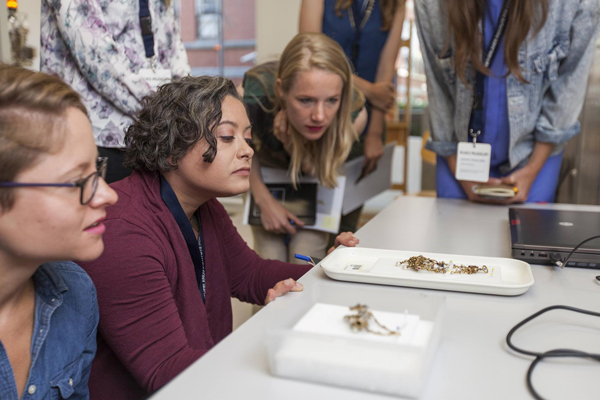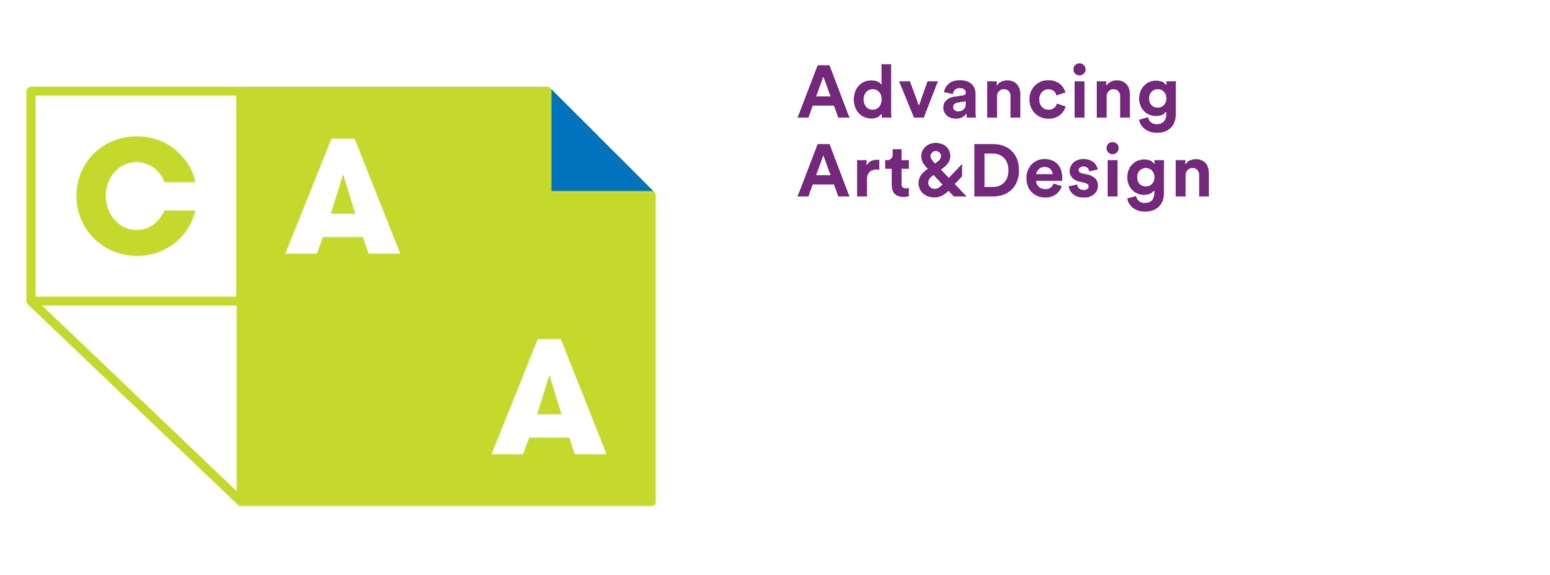CAA News Today
Anja Foerschner and Marta Jovanovic
posted by CAA — March 25, 2019
The weekly CAA Conversations Podcast continues the vibrant discussions initiated at our Annual Conference. Listen in each week as educators explore arts and pedagogy, tackling everything from the day-to-day grind to the big, universal questions of the field.
CAA podcasts are on iTunes. Click here to subscribe.
This week, Anja Foerschner and Marta Jovanovic discuss feminist art.
Dr. Anja Foerschner is a curator, scholar, and professor at the Node Center for Curatorial Studies in Berlin.
Marta Jovanovic is an artist and founder of PerformanceHUB in Belgrade.
Ashley Gardini and Cheyanne Cortez
posted by CAA — March 18, 2019
The weekly CAA Conversations Podcast continues the vibrant discussions initiated at our Annual Conference. Listen in each week as educators explore arts and pedagogy, tackling everything from the day-to-day grind to the big, universal questions of the field.
CAA podcasts are on iTunes. Click here to subscribe.
This week, Ashley Gardini and Cheyanne Cortez discuss the realities of adjuncting.
They are both adjunct instructors at several community colleges in northern California.
Meet Cali Buckley, CAA’s New Grants and Special Programs Manager
posted by CAA — March 14, 2019

Cali Buckley takes part in the Rijksmuseum’s Museum Objects as Evidence: Approaches to the Material World Summer School, 2018. Photo: Thijs Gerbrandy
We’re delighted to introduce Cali Buckley, CAA’s new Grants and Special Programs Manager and RAAMP Coordinator, who began her full-time role in January after working part-time as the CAA Programs Assistant in 2017. She received her PhD from Penn State University on interactive anatomical models and their creation by craftsmen in the early modern era. Joelle Te Paske, CAA Media and Content Manager, spoke with her in late January to learn more about her research and her hopes for the Resources for Academic Art Museum Professionals (RAAMP) program, which provides publicly accessible resources to academic museum professionals.
Joelle Te Paske: Thanks for taking the time to chat, Cali. So to begin, where are you from?
Cali Buckley: I’m from Pottsville, Pennsylvania. It’s only about three hours from here. It’s north of Philly, best known for Yuengling beer which is the oldest brewery in America. That’s our claim to fame.
JTP: Good to know. And you worked with CAA a few years ago, correct?
CB: Yes, I moved to New York after my Fulbright and worked for CAA for six months as a programs assistant part-time while I was finishing my dissertation. Once I defended and graduated, I moved back to Germany.
I actually have long ties with CAA. Right out of college, I worked for Penn State University Press on art history books. I was able to actually attend CAA and talk to authors, and I worked at the Book and Trade Fair for about three years. It was fun. You can hear people talking about their wonderful book ideas. If I had more time, I would just sit around and see how people pitch these things because it’s fascinating.
I went to Penn State for journalism and then went into publishing right after graduating—I worked on history books and then got really into art history and thought about all the possibilities. Because I guess I had this much narrower idea of traditional art history. And then working on some of these new books really expanded my sense of what that could be.
JTP: That’s great.
CB: I knew some folks in our art history department at Penn State through the editorial board, and I started talking to them about the possibility of my doing my masters there. And I met one of my professors through an editor there. So I planned on going for my masters and then back into publishing, but I completely fell in love with it. I found some great topics, and I just kind of wanted to keep moving forward.
I started going to CAA as a graduate student, so no longer in the Book and Trade Fair. I was part of this group called The Graduate Student Association for Visual Culture. And we would apply for money from Penn State to get groups of us to go to CAA every year. So we would have this group caravan to CAA, all the art historians.
JTP: Sounds ideal.
CB: It’s wonderful. We created this Valentine’s Day tradition because CAA usually falls over Valentine’s Day. And we still get together on the 14th and watch our favorite movie and eat pizza.
JTP: Are you going to do it this year?
CB: Yes, yes, absolutely.
So I started with doing the Book and Trade Fair at CAA. Then I went as a graduate student, gave a talk at CAA in Chicago a few years back. And the same day participated in a roundtable in publishing. CAA’s been huge in my life.
JTP: I’d love to speak a bit about your research, too—early anatomical models and the control of women in medicine.
CB: Originally, when I went into publishing, I was doing weird research projects on interactive books and books as objects. And I used to give talks at Columbia to journalism students in the summer about how to create physical books and how it’s different from books online. How to work with the movement of books and do all these funny things that literary magazines were experimenting with. And then I found this sixteenth-century version of what I was talking about, in the form of an anatomical model.
These have become much more popular in the last ten years but some of these [models] had layers. So they were just images of the body with layers showing the different organs and systems. And that idea of movement and interactivity was fascinating—and a lot of them are inaccurate, even for their time, which makes them even more interesting.
There are all these different layers to audiences, whether you’re trying to highlight the accuracy, which a lot of these are not, or the visuality and the interactivity. And that seems to be more important.
Then I got into ivory models, which is a huge project of mine, creating a whole catalogue of them. That’s a big part of my dissertation.
JTP: Interesting.
CB: I found 180 in the world and I have new people emailing me every year. They’re a much bigger phenomenon than we thought and I’ve done quite a bit of research in Germany to pull these threads together and find out more about their history. I’ve been trying to bring these to light and hopefully I’ll have an article out soon.
JTP: That’s terrific. I’m curious—what is one of your favorite CAA conference memories?
CB: I think one of the great memories was actually an event connected to CAA where I was giving a talk with someone from The Art Institute of Chicago and they let us do a private showing of prints and different objects [at the museum]. Some of the prints were the actual interactive prints that I had worked on.
JTP: That’s always exciting, to be in the same room with objects you’ve studied.
Do you have a favorite exhibition you’ve seen recently?
CB: I just went to the Brueghel exhibition in Vienna and it was amazing. I mean, it was really well done and it went through both his history and paintings and a lot of his earlier drawings and sketches. But it also included a lot of the process to make the materials—some of the wooden planks and those sorts of thing that he used, and the process of painting and printing. That process stuff was really interesting. I think that should be in a lot more exhibitions.
JTP: I agree. My first job was as a registrar at a gallery and I can never quite divorce myself from “How much did the crate cost?”! Because you have a different sense of the process.
CB: Absolutely. I work a lot on materiality. I’m interested in the process of how a work was made, what it’s made of, and how the material affects it. I actually started taking a lot more art classes in different areas to get a feel for it.
I took a class in wax modeling with someone who does wax moulages and restoration. Moulages are generally medical things. So I essentially made a moulage using wax of some skin condition! That was a fun workshop. I was at the Narrenturm which is an old insane asylum in Vienna that now houses a pathological museum. And then you spend a couple of hours making these wax moulages. It was just such a bizarre and wonderful day.
JTP: That does sound bizarre and wonderful.
So, thinking forward to your work with RAAMP, what do you find the most exciting part of that resource?
CB: I’m excited to be [at CAA] and working on a diversity of projects so that I get that bigger, that broader umbrella of what’s new and exciting outside of my little area of the research world. Part of that is the RAAMP program, which really allows people in various facets of the academic and museum worlds to share experiences and have discussions about issues facing those institutions—and those who they serve—today. I love the idea of having meetings and sharing discussions online, because that way they are more accessible. Our Coffee Gatherings are like afternoon meetings at a café with a small audience that can discuss matters in a casual way, but they are also recorded now so students can always watch these later to gain insight into particular matters. The video practica are similar, but more streamlined with one person discussing a specific topic. I can’t wait to get more Coffee Gatherings together because those small group discussions can be really valuable.
JTP: How do you see of the role of academic art museums moving forward?
CB: Academic art museums are as integral as ever to education, but they are facing different issues as time goes on while also dealing with age-old dilemmas. They need to learn how to use the latest technology and how to deal with the latest controversies over artwork, but they also need to engage students. The whole idea of RAAMP is to provide resources for academic art museums to tackle these problems. Part of that is providing a network of professionals who share their expertise.
I do think that museums have to be aware of the social environment and how to contend with criticism. Our session at the 2019 conference allows us to open up this topic to see how artists and professionals deal with some very serious issues of artwork being interpreted as offensive. Artwork is inherently open to interpretation, so I think it’s important to discuss how museums act as mediators to a degree—and how their role is balanced with their place in an academic institution.
I should add that one of my favorite teaching experiences was being able to introduce first-year students to the Palmer Museum of Art at Penn State and asking them to describe the giant [Helen] Frankenthaler painting we had hanging there. There’s nothing quite like it when a student realizes that they have history right in front of them.
Mitchell Blessing and Kristi Oliver
posted by CAA — March 11, 2019
The weekly CAA Conversations Podcast continues the vibrant discussions initiated at our Annual Conference. Listen in each week as educators explore arts and pedagogy, tackling everything from the day-to-day grind to the big, universal questions of the field.
CAA podcasts are on iTunes. Click here to subscribe.
This week, Mitchell Blessing and Kristi Oliver discuss technology in art programs.
Mitchell Blessing is an assistant professor in the Department of Technology, Art, and Design at Bemedji State University.
Kristi Oliver is an assistant professor of art education at the University of Massachussetts – Dartmouth.
Jason Grunebaum and Sarita Heer
posted by CAA — March 04, 2019
The weekly CAA Conversations Podcast continues the vibrant discussions initiated at our Annual Conference. Listen in each week as educators explore arts and pedagogy, tackling everything from the day-to-day grind to the big, universal questions of the field.
CAA podcasts are on iTunes. Click here to subscribe.
This week, Jason Grunebaum and Sarita Heer discuss contingent faculty unions behind the scenes.
Jason Grunebaum is a lecturer in Hindi in the Department of South Asian Languages and Civilizations at the University of Chicago.
Dr. Sarita Heer is an instructor of Art History in the Fine and Performing Arts Department at Loyola University Chicago.
Christian Benefiel and Meg Mitchell
posted by CAA — February 25, 2019
The weekly CAA Conversations Podcast continues the vibrant discussions initiated at our Annual Conference. Listen in each week as educators explore arts and pedagogy, tackling everything from the day-to-day grind to the big, universal questions of the field.
CAA podcasts are on iTunes. Click here to subscribe.
This week, Christian Benefiel and Meg Mitchell ask: “Do we owe it to our students to teach practical skills?”
Christian Benefiel is an assistant professor of Art – Sculpture at Shepherd University in Shepherdstown, West Virginia.
Meg Mitchell is an assistant professor of Art at University of Wisconsin–Madison.
Monica Zandi and Stephanie Cortazzo
posted by CAA — February 11, 2019
The weekly CAA Conversations Podcast continues the vibrant discussions initiated at our Annual Conference. Listen in each week as educators explore arts and pedagogy, tackling everything from the day-to-day grind to the big, universal questions of the field.
CAA podcasts are on iTunes. Click here to subscribe.
This week, Monica Zandi and Stephanie Cortazzo discuss “Body/Cut” and the Brooklyn Collage Collective.
Monica Zandi is a writer, educator, and graduate art student at Hunter College.
Stephanie Cortazzo is a multimedia artist who recently had a show entitled Cosmic Crisis and is in the Brooklyn Collage Collective (www.brooklyncollagecollective.com/).
Rosie Liljenquist and Anne Diekema
posted by CAA — February 04, 2019
The weekly CAA Conversations Podcast continues the vibrant discussions initiated at our Annual Conference. Listen in each week as educators explore arts and pedagogy, tackling everything from the day-to-day grind to the big, universal questions of the field.
CAA podcasts are on iTunes. Click here to subscribe.
This week, Rosie Liljenquist and Anne Diekema discuss Open Educational Resources (OER).
Rose Liljenquist is an Open Educational Resources librarian at Gerald Sherratt Library, Southern Utah University. Anne Diekema is also a librarian at Gerald Sherratt Library and an assistant professor at Southern Utah University.
Emil Robinson and Squeak Carnwath
posted by CAA — January 28, 2019
The weekly CAA Conversations Podcast continues the vibrant discussions initiated at our Annual Conference. Listen in each week as educators explore arts and pedagogy, tackling everything from the day-to-day grind to the big, universal questions of the field.
CAA podcasts are now on iTunes. Click here to subscribe.
This week, Emil Robinson and Squeak Carnwath discuss trust and voice in the studio, and how they approach teaching painting.
Emil Robinson is Assistant Professor in the School of Design at the University of Cincinnati.
Squeak Carnwath is an artist who maintains a studio in Oakland, California, and is a Professor Emerita from UC Berkeley.
Rachel Clarke and Peter Williams
posted by CAA — January 21, 2019
The weekly CAA Conversations Podcast continues the vibrant discussions initiated at our Annual Conference. Listen in each week as educators explore arts and pedagogy, tackling everything from the day-to-day grind to the big, universal questions of the field.
CAA podcasts are now on iTunes. Click here to subscribe.
This week, Rachel Clarke and Peter Williams discuss interdisciplinary and community-involved curriculum.
Rachel Clarke is professor of New Media Art at California State University, Sacramento. Her work intertwines themes of nature, culture, and technology; combining physical and virtual modes of making.
Peter Williams is a new media artist specializing in interactive installation, and an assistant professor at California State University, Sacramento.


